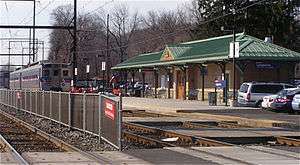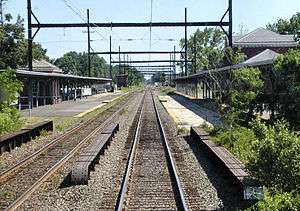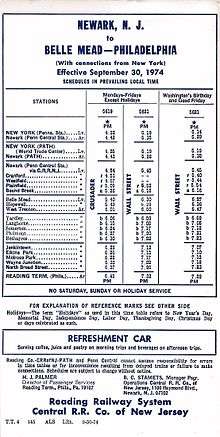West Trenton Line (SEPTA)
The West Trenton Line is a SEPTA Regional Rail line connecting Center City Philadelphia to the West Trenton section of Ewing Township, New Jersey.
| West Trenton Line | ||||||||||||||||||||||||||||||||||||||||||||||||||||||||||||||||||||||||||||||||||||||||||||||||||||||||||||||||||||||||||||||||||||||||||||||||||||||||||||||||||||||||||||||||||||||||||||||||||||||||||||||||||||||||||||||||||||||||||||||||||||||||||||||||||||||||||||||||||||||||||||||||||||||||||||||||||||||||||||||||||||||||||||||||||||||||||||||||||||||||||||||||||||||||||||||||||||||||||||||||||||||||||||||||||||||||||||||||||||||||||||||||||||||||||||||||||||
|---|---|---|---|---|---|---|---|---|---|---|---|---|---|---|---|---|---|---|---|---|---|---|---|---|---|---|---|---|---|---|---|---|---|---|---|---|---|---|---|---|---|---|---|---|---|---|---|---|---|---|---|---|---|---|---|---|---|---|---|---|---|---|---|---|---|---|---|---|---|---|---|---|---|---|---|---|---|---|---|---|---|---|---|---|---|---|---|---|---|---|---|---|---|---|---|---|---|---|---|---|---|---|---|---|---|---|---|---|---|---|---|---|---|---|---|---|---|---|---|---|---|---|---|---|---|---|---|---|---|---|---|---|---|---|---|---|---|---|---|---|---|---|---|---|---|---|---|---|---|---|---|---|---|---|---|---|---|---|---|---|---|---|---|---|---|---|---|---|---|---|---|---|---|---|---|---|---|---|---|---|---|---|---|---|---|---|---|---|---|---|---|---|---|---|---|---|---|---|---|---|---|---|---|---|---|---|---|---|---|---|---|---|---|---|---|---|---|---|---|---|---|---|---|---|---|---|---|---|---|---|---|---|---|---|---|---|---|---|---|---|---|---|---|---|---|---|---|---|---|---|---|---|---|---|---|---|---|---|---|---|---|---|---|---|---|---|---|---|---|---|---|---|---|---|---|---|---|---|---|---|---|---|---|---|---|---|---|---|---|---|---|---|---|---|---|---|---|---|---|---|---|---|---|---|---|---|---|---|---|---|---|---|---|---|---|---|---|---|---|---|---|---|---|---|---|---|---|---|---|---|---|---|---|---|---|---|---|---|---|---|---|---|---|---|---|---|---|---|---|---|---|---|---|---|---|---|---|---|---|---|---|---|---|---|---|---|---|---|---|---|---|---|---|---|---|---|---|---|---|---|---|---|---|---|---|---|---|---|---|---|---|---|---|---|---|---|---|---|---|---|---|---|---|---|---|---|---|---|---|---|---|---|---|---|---|---|---|---|---|---|---|---|---|---|---|---|---|---|---|---|---|---|---|---|---|---|---|---|---|---|---|---|---|---|---|---|---|---|---|---|---|---|---|---|---|---|---|---|---|---|---|---|---|---|---|---|---|---|
 Langhorne station on the West Trenton Line | ||||||||||||||||||||||||||||||||||||||||||||||||||||||||||||||||||||||||||||||||||||||||||||||||||||||||||||||||||||||||||||||||||||||||||||||||||||||||||||||||||||||||||||||||||||||||||||||||||||||||||||||||||||||||||||||||||||||||||||||||||||||||||||||||||||||||||||||||||||||||||||||||||||||||||||||||||||||||||||||||||||||||||||||||||||||||||||||||||||||||||||||||||||||||||||||||||||||||||||||||||||||||||||||||||||||||||||||||||||||||||||||||||||||||||||||||||||
| Overview | ||||||||||||||||||||||||||||||||||||||||||||||||||||||||||||||||||||||||||||||||||||||||||||||||||||||||||||||||||||||||||||||||||||||||||||||||||||||||||||||||||||||||||||||||||||||||||||||||||||||||||||||||||||||||||||||||||||||||||||||||||||||||||||||||||||||||||||||||||||||||||||||||||||||||||||||||||||||||||||||||||||||||||||||||||||||||||||||||||||||||||||||||||||||||||||||||||||||||||||||||||||||||||||||||||||||||||||||||||||||||||||||||||||||||||||||||||||
| Type | Commuter rail | |||||||||||||||||||||||||||||||||||||||||||||||||||||||||||||||||||||||||||||||||||||||||||||||||||||||||||||||||||||||||||||||||||||||||||||||||||||||||||||||||||||||||||||||||||||||||||||||||||||||||||||||||||||||||||||||||||||||||||||||||||||||||||||||||||||||||||||||||||||||||||||||||||||||||||||||||||||||||||||||||||||||||||||||||||||||||||||||||||||||||||||||||||||||||||||||||||||||||||||||||||||||||||||||||||||||||||||||||||||||||||||||||||||||||||||||||||
| System | SEPTA Regional Rail | |||||||||||||||||||||||||||||||||||||||||||||||||||||||||||||||||||||||||||||||||||||||||||||||||||||||||||||||||||||||||||||||||||||||||||||||||||||||||||||||||||||||||||||||||||||||||||||||||||||||||||||||||||||||||||||||||||||||||||||||||||||||||||||||||||||||||||||||||||||||||||||||||||||||||||||||||||||||||||||||||||||||||||||||||||||||||||||||||||||||||||||||||||||||||||||||||||||||||||||||||||||||||||||||||||||||||||||||||||||||||||||||||||||||||||||||||||
| Status | Operating | |||||||||||||||||||||||||||||||||||||||||||||||||||||||||||||||||||||||||||||||||||||||||||||||||||||||||||||||||||||||||||||||||||||||||||||||||||||||||||||||||||||||||||||||||||||||||||||||||||||||||||||||||||||||||||||||||||||||||||||||||||||||||||||||||||||||||||||||||||||||||||||||||||||||||||||||||||||||||||||||||||||||||||||||||||||||||||||||||||||||||||||||||||||||||||||||||||||||||||||||||||||||||||||||||||||||||||||||||||||||||||||||||||||||||||||||||||
| Termini | Penn Medicine West Trenton | |||||||||||||||||||||||||||||||||||||||||||||||||||||||||||||||||||||||||||||||||||||||||||||||||||||||||||||||||||||||||||||||||||||||||||||||||||||||||||||||||||||||||||||||||||||||||||||||||||||||||||||||||||||||||||||||||||||||||||||||||||||||||||||||||||||||||||||||||||||||||||||||||||||||||||||||||||||||||||||||||||||||||||||||||||||||||||||||||||||||||||||||||||||||||||||||||||||||||||||||||||||||||||||||||||||||||||||||||||||||||||||||||||||||||||||||||||
| Stations | 23 | |||||||||||||||||||||||||||||||||||||||||||||||||||||||||||||||||||||||||||||||||||||||||||||||||||||||||||||||||||||||||||||||||||||||||||||||||||||||||||||||||||||||||||||||||||||||||||||||||||||||||||||||||||||||||||||||||||||||||||||||||||||||||||||||||||||||||||||||||||||||||||||||||||||||||||||||||||||||||||||||||||||||||||||||||||||||||||||||||||||||||||||||||||||||||||||||||||||||||||||||||||||||||||||||||||||||||||||||||||||||||||||||||||||||||||||||||||
| Daily ridership | 10,807 (FY 2018)[1] | |||||||||||||||||||||||||||||||||||||||||||||||||||||||||||||||||||||||||||||||||||||||||||||||||||||||||||||||||||||||||||||||||||||||||||||||||||||||||||||||||||||||||||||||||||||||||||||||||||||||||||||||||||||||||||||||||||||||||||||||||||||||||||||||||||||||||||||||||||||||||||||||||||||||||||||||||||||||||||||||||||||||||||||||||||||||||||||||||||||||||||||||||||||||||||||||||||||||||||||||||||||||||||||||||||||||||||||||||||||||||||||||||||||||||||||||||||
| Website | septa.org | |||||||||||||||||||||||||||||||||||||||||||||||||||||||||||||||||||||||||||||||||||||||||||||||||||||||||||||||||||||||||||||||||||||||||||||||||||||||||||||||||||||||||||||||||||||||||||||||||||||||||||||||||||||||||||||||||||||||||||||||||||||||||||||||||||||||||||||||||||||||||||||||||||||||||||||||||||||||||||||||||||||||||||||||||||||||||||||||||||||||||||||||||||||||||||||||||||||||||||||||||||||||||||||||||||||||||||||||||||||||||||||||||||||||||||||||||||
| Operation | ||||||||||||||||||||||||||||||||||||||||||||||||||||||||||||||||||||||||||||||||||||||||||||||||||||||||||||||||||||||||||||||||||||||||||||||||||||||||||||||||||||||||||||||||||||||||||||||||||||||||||||||||||||||||||||||||||||||||||||||||||||||||||||||||||||||||||||||||||||||||||||||||||||||||||||||||||||||||||||||||||||||||||||||||||||||||||||||||||||||||||||||||||||||||||||||||||||||||||||||||||||||||||||||||||||||||||||||||||||||||||||||||||||||||||||||||||||
| Operator(s) | SEPTA Regional Rail | |||||||||||||||||||||||||||||||||||||||||||||||||||||||||||||||||||||||||||||||||||||||||||||||||||||||||||||||||||||||||||||||||||||||||||||||||||||||||||||||||||||||||||||||||||||||||||||||||||||||||||||||||||||||||||||||||||||||||||||||||||||||||||||||||||||||||||||||||||||||||||||||||||||||||||||||||||||||||||||||||||||||||||||||||||||||||||||||||||||||||||||||||||||||||||||||||||||||||||||||||||||||||||||||||||||||||||||||||||||||||||||||||||||||||||||||||||
| Rolling stock | Electric Multiple Units, push-pull trains | |||||||||||||||||||||||||||||||||||||||||||||||||||||||||||||||||||||||||||||||||||||||||||||||||||||||||||||||||||||||||||||||||||||||||||||||||||||||||||||||||||||||||||||||||||||||||||||||||||||||||||||||||||||||||||||||||||||||||||||||||||||||||||||||||||||||||||||||||||||||||||||||||||||||||||||||||||||||||||||||||||||||||||||||||||||||||||||||||||||||||||||||||||||||||||||||||||||||||||||||||||||||||||||||||||||||||||||||||||||||||||||||||||||||||||||||||||
| Technical | ||||||||||||||||||||||||||||||||||||||||||||||||||||||||||||||||||||||||||||||||||||||||||||||||||||||||||||||||||||||||||||||||||||||||||||||||||||||||||||||||||||||||||||||||||||||||||||||||||||||||||||||||||||||||||||||||||||||||||||||||||||||||||||||||||||||||||||||||||||||||||||||||||||||||||||||||||||||||||||||||||||||||||||||||||||||||||||||||||||||||||||||||||||||||||||||||||||||||||||||||||||||||||||||||||||||||||||||||||||||||||||||||||||||||||||||||||||
| Track gauge | 4 ft 8 1⁄2 in (1,435 mm) standard gauge | |||||||||||||||||||||||||||||||||||||||||||||||||||||||||||||||||||||||||||||||||||||||||||||||||||||||||||||||||||||||||||||||||||||||||||||||||||||||||||||||||||||||||||||||||||||||||||||||||||||||||||||||||||||||||||||||||||||||||||||||||||||||||||||||||||||||||||||||||||||||||||||||||||||||||||||||||||||||||||||||||||||||||||||||||||||||||||||||||||||||||||||||||||||||||||||||||||||||||||||||||||||||||||||||||||||||||||||||||||||||||||||||||||||||||||||||||||
| Electrification | Catenary | |||||||||||||||||||||||||||||||||||||||||||||||||||||||||||||||||||||||||||||||||||||||||||||||||||||||||||||||||||||||||||||||||||||||||||||||||||||||||||||||||||||||||||||||||||||||||||||||||||||||||||||||||||||||||||||||||||||||||||||||||||||||||||||||||||||||||||||||||||||||||||||||||||||||||||||||||||||||||||||||||||||||||||||||||||||||||||||||||||||||||||||||||||||||||||||||||||||||||||||||||||||||||||||||||||||||||||||||||||||||||||||||||||||||||||||||||||
| ||||||||||||||||||||||||||||||||||||||||||||||||||||||||||||||||||||||||||||||||||||||||||||||||||||||||||||||||||||||||||||||||||||||||||||||||||||||||||||||||||||||||||||||||||||||||||||||||||||||||||||||||||||||||||||||||||||||||||||||||||||||||||||||||||||||||||||||||||||||||||||||||||||||||||||||||||||||||||||||||||||||||||||||||||||||||||||||||||||||||||||||||||||||||||||||||||||||||||||||||||||||||||||||||||||||||||||||||||||||||||||||||||||||||||||||||||||
Route

The West Trenton Line connects Center City, Philadelphia with the West Trenton section of Ewing, New Jersey .The line splits from the SEPTA Main Line at Jenkintown, running northeast. At Bethayres, it crosses the Pennypack Trail that runs along the former Philadelphia, Newtown and New York Railroad, which once connected with the Fox Chase Line. At Oakford, the former New York Short Line Railroad, once part of the Reading's main line to West Trenton and Jersey City and currently CSX's Trenton Subdivision, merges. North of Oakford, the West Trenton Line runs parallel to CSX's Trenton Subdivision. The West Trenton Railroad Bridge, a concrete arch bridge, crosses the Delaware River to the final stop at West Trenton.
History

Like all of the Reading Company's commuter lines, the West Trenton Line was electrified in the early 1930s and has a mix of at-grade and grade separated crossings. Electrified service to West Trenton was opened on July 26, 1931. The RDG planned to also electrify tracks between West Trenton and the CNJ Terminal in Jersey City for long-distance service, but had to drop plans for electrification outside of the commuter service area due to economic setbacks as a result of the Great Depression.
The line north of the split at Jenkintown was originally built as the National Railway project, opened on May 1, 1876, to provide an alternate to the United New Jersey Railroad and Canal Companies' monopoly over Philadelphia-New York City travel. From Jenkintown to the Delaware River it was built by the North Pennsylvania Railroad as a branch, while the New Jersey section was built by the Delaware and Bound Brook Railroad, merging with the Central Railroad of New Jersey at Bound Brook. In addition to the Reading Company, which leased the North Pennsylvania Railroad in 1879, the Baltimore and Ohio Railroad also used the line for passenger and freight service to New York City, including its famed Royal Blue service. In 1976 the Reading merged into Conrail, and in 1983 SEPTA took over operations.
Prior to 1981, limited service continued north to Newark, New Jersey (Jersey City prior to the Aldene Plan of the 1960s), using Budd Company-built Diesel multiple units. This service was the last remains of the Reading's Crusader service, which began in 1937 using streamlined steam locomotives and passenger cars. SEPTA ended service beyond West Trenton on August 1, 1981; connecting NJT diesel service lasted until December 1982.[2][3] NJT has since considered service resumption on their West Trenton Line.[4]
Beginning in 1984 the route was designated R1 West Trenton as part of SEPTA's diametrical reorganization of its lines. West Trenton Line trains operated through the city center to the Airport Line on the ex-Pennsylvania side of the system.[5] In later years this behavior changed; the line was designated R3 West Trenton and trains continued on to the Media/Elwyn Line on weekdays and the Airport Line on weekends.[6] The R-number naming system was dropped on July 25, 2010.[7] As of 2019, most West Trenton Line trains terminate at 30th Street Station on weekdays, while most evening trains operate to Elwyn on the Media/Elwyn Line. Most weekend trains operate to Malvern or Thorndale on the Paoli/Thorndale Line.[8]
Between Oakford and West Trenton, the West Trenton Line previously followed CSX's Trenton Subdivision until passenger and freight operations were separated. SEPTA and CSX trains were separated between Woodbourne and West Trenton in 2015 ahead of the implementation of positive train control (PTC) on the West Trenton Line.[9]
SEPTA activated PTC on the West Trenton Line on October 24, 2016.[10]
On April 9, 2020, service on the line was suspended due to the COVID-19 pandemic,[11] though stations between Center City and Jenkintown–Wyncote were still being served by other rail services. Service resumed on June 15, 2020.[12]
Stations

The West Trenton Line includes the following stations north of the Center City Commuter Connection; stations indicated with a gray background are closed. The train expresses from Bethayres to Temple University inbound on some trains in the morning and expresses outbound from Temple University to Bethayres on some trains in the evening.
| State | Zone[13] | Location | Station | Miles (km) from Center City |
Date opened | Connections / notes[14] |
|---|---|---|---|---|---|---|
| PA | C | Temple University | Temple University |
2.1 (3.4) | SEPTA Regional Rail: all lines | |
| 1 | Nicetown–Tioga, Philadelphia | Wayne Junction |
5.1 (8.2) | SEPTA Regional Rail: Chestnut Hill East, Fox Chase, Lansdale/Doylestown, Warminster lines SEPTA City Bus: 2, 23, 53, 75 | ||
| Olney-Oak Lane, Philadelphia | ||||||
| Logan | Discontinued October 4, 1992[15] | |||||
| Tabor | ||||||
| Fern Rock Transportation Center |
7.3 (11.7) | SEPTA Regional Rail: Lansdale/Doylestown, Warminster lines SEPTA City Transit: Broad Street Line SEPTA City Bus: 4, 28, 57, 70 | ||||
| 2 | Melrose Park | Melrose Park |
8.4 (13.5) | SEPTA Regional Rail: Lansdale/Doylestown, Warminster lines | ||
| Elkins Park | Elkins Park | 9.2 (14.8) | May 14, 1899[16] | SEPTA Regional Rail: Lansdale/Doylestown, Warminster SEPTA City Bus: 28 | ||
| 3 | Jenkintown | Jenkintown–Wyncote | 10.8 (17.4) | SEPTA Regional Rail: Lansdale/Doylestown, Warminster SEPTA City Bus: 77 | ||
| Noble | Noble | 12.0 (19.3) | SEPTA City Bus: 55 | |||
| Rydal | Rydal | 12.8 (20.6) | ||||
| Abington | Meadowbrook | 13.8 (22.2) | ||||
| Bethayres | Bethayres |
15.1 (24.3) | SEPTA City Bus: 24, 88 | |||
| Huntingdon Valley | Philmont |
16.4 (26.4) | ||||
| Somerton, Philadelphia | Forest Hills |
17.7 (28.5) | SEPTA City Bus: 84 | |||
| Somerton |
18.2 (29.3) | SEPTA City Bus: 58, 84 | ||||
| Bensalem Township | Trevose |
19.9 (32.0) | ||||
| Neshaminy Falls |
21.1 (34.0) | SEPTA City Bus: 58 | ||||
| Penndel | Parkland | Closed March 1978[17] | ||||
| 4 | Langhorne | Langhorne | 23.9 (38.5) | SEPTA City Bus: 14 SEPTA Suburban Bus: 130 | ||
| Middletown Township | ||||||
| Fairless Junction | Closed March 1978[17] | |||||
| Woodbourne | 26.4 (42.5) | |||||
| Yardley | Yardley | 30.8 (49.6) | ||||
| NJ | NJ | West Trenton | West Trenton | 32.5 (52.3) | NJ Transit Bus: 608 |
Ridership
Between FY 2008–FY 2015 yearly ridership on the West Trenton Line held steady at 3.3–3.5 million, before declining to 3 million by FY 2018.[note 1]
Notes
References
- "Fiscal Year 2020 Annual Service Plan" (PDF). SEPTA. June 2019. p. 42. Retrieved December 14, 2019.
- Williams, Gerry (1998). Trains, Trolleys & Transit: A Guide to Philadelphia Area Rail Transit. Piscataway, New Jersey: Railpace Company. p. 71. ISBN 978-0-9621541-7-1.
- Pawson, John (March 1993). "New Backing for "Crusader" Route". The Delaware Valley Rail Passenger. Delaware Valley Association of Railroad Passengers. 13 (3).
- "Chapter 1: Purpose and Need" (PDF). Proposed Restoration of Passenger Rail Service on the West Trenton Line Draft Environmental Assessment. New Jersey Transit. November 2007. p. 1-1.
- Vuchic, Vukan; Kikuchi, Shinya (1984). General Operations Plan for the SEPTA Regional High Speed System. Philadelphia: SEPTA. pp. 2–8.
- "R3 West Trenton" (PDF). SEPTA. June 21, 2009. Archived from the original (PDF) on November 27, 2009. Retrieved August 20, 2016.
- Lustig, David (November 2010). "SEPTA makeover". Trains Magazine. Kalmbach Publishing: 26.
- "West Trenton Line" (PDF). SEPTA. December 16, 2018. Retrieved December 24, 2018.
- "SEPTA West Trenton Passenger Service To Separate from CSX Freight Operations". SEPTA. August 20, 2015. Retrieved December 24, 2018.
- "Positive Train Control Update". SEPTA. May 1, 2017. Retrieved May 17, 2017.
- "Service Information". SEPTA. Retrieved April 14, 2020.
- "SEPTA Regional Rail & Rail Transit Lifeline Service" (PDF). SEPTA. 2020. Retrieved April 14, 2020.
- "West Trenton Line Timetable" (PDF). Philadelphia, Pennsylvania: Southeastern Pennsylvania Transportation Authority. September 10, 2017. Retrieved October 18, 2017.
- "Trenton Line Timetable" (PDF). Philadelphia, Pennsylvania: Southeastern Pennsylvania Transportation Authority. September 10, 2017. Retrieved October 17, 2017.
- "New Rail Schedules Set". The Philadelphia Inquirer. Philadelphia, Pennsylvania. October 2, 1992. p. 36. Retrieved October 19, 2017 – via Newspapers.com.

- "Elkins Station Opened at Ogontz Park". The Philadelphia Times. May 15, 1899. p. 3. Retrieved July 3, 2019 – via Newspapers.com.

- "Rail Hikes Stalled". The Philadelphia Daily News. March 23, 1978. p. 58B. Retrieved July 4, 2019 – via Newspapers.com.

- "Fiscal Year 2019 Annual Service Plan" (PDF). SEPTA. June 2018. p. 74. Retrieved December 14, 2019.
- "Fiscal Year 2018 Annual Service Plan" (PDF). SEPTA. June 2017. p. 44. Retrieved December 14, 2019.
- "Fiscal Year 2017 Annual Service Plan" (PDF). SEPTA. October 2016. p. 70. Retrieved December 14, 2019.
- "Fiscal Year 2016 Annual Service Plan" (PDF). SEPTA. June 2015. p. 94. Retrieved December 14, 2019.
- "Fiscal Year 2015 Annual Service Plan" (PDF). SEPTA. May 2014. p. 60. Retrieved December 14, 2019.
- "Fiscal Year 2014 Annual Service Plan" (PDF). SEPTA. May 2013. p. 44. Retrieved December 14, 2019.
- "Fiscal Year 2013 Annual Service Plan" (PDF). SEPTA. May 2012. p. 55. Retrieved December 14, 2019.
- "Fiscal Year 2012 Annual Service Plan" (PDF). SEPTA. July 2011. p. 94. Retrieved December 14, 2019.
- "Fiscal Year 2011 Annual Service Plan" (PDF). SEPTA. June 2010. p. 70. Retrieved December 14, 2019.
- "Fiscal Year 2010 Annual Service Plan" (PDF). SEPTA. June 2009. p. 63. Retrieved December 14, 2019.
External links
| Wikimedia Commons has media related to West Trenton Line (SEPTA). |

